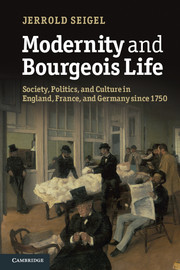 Modernity and Bourgeois Life
Modernity and Bourgeois Life Book contents
- Frontmatter
- Contents
- Illustrations
- Preface
- 1 Introduction: ends and means
- Part I Contours of modernity
- 3 Monarchical centralization, privilege, and conflict: France
- 4 Localism, state-building, and bürgerliche Gesellschaft: Germany
- 5 Modern industry, class, and party politics in nineteenth-century England
- 6 France and bourgeois France: from teleocracy to autonomy
- 7 One special path: modern industry, politics, and bourgeois life in Germany
- Part II Calculations and lifeworlds
- 9 Men and women
- 10 Bourgeois morals: from Victorianism to modern sexuality
- 11 Jews as bourgeois and network people
- Part III A culture of means
- 13 Bourgeois and others
- 14 Bourgeois life and the avant-garde
- 15 Conclusion
- Notes
- Index
9 - Men and women
Published online by Cambridge University Press: 05 June 2012
- Frontmatter
- Contents
- Illustrations
- Preface
- 1 Introduction: ends and means
- Part I Contours of modernity
- 3 Monarchical centralization, privilege, and conflict: France
- 4 Localism, state-building, and bürgerliche Gesellschaft: Germany
- 5 Modern industry, class, and party politics in nineteenth-century England
- 6 France and bourgeois France: from teleocracy to autonomy
- 7 One special path: modern industry, politics, and bourgeois life in Germany
- Part II Calculations and lifeworlds
- 9 Men and women
- 10 Bourgeois morals: from Victorianism to modern sexuality
- 11 Jews as bourgeois and network people
- Part III A culture of means
- 13 Bourgeois and others
- 14 Bourgeois life and the avant-garde
- 15 Conclusion
- Notes
- Index
Summary
Among the aspects of modernity whose relationship to bourgeois life have often been debated, none are more significant than the linked topics of relations between men and women, and the moral codes and attitudes that regulate them. In this chapter and the next I will try to show that the evolution of gender relations and the historical place of what is often called “Victorian” morality evolved in parallel between the middle of the eighteenth century and the end of the nineteenth: each began by entering a phase that gave a sharper and more defined quality or shape to attitudes and relationships that existed previously but that had been treated more informally and flexibly, and each ended by exhibiting a marked relaxation of the rigidities introduced in that initial moment. A major reason for this parallel was that both were similarly affected by the expansion and thickening of networks of means, and the two stages correspond, if somewhat imprecisely, to the successive moments in the development of modernity we have sought to distinguish in previous chapters. One reason the correspondence was imperfect was that impulses which only began to find significant realization in the second phase were already at work in the first, their push toward gender equality and moral flexibility having been introduced alongside forces that pressed in the opposite direction. This makes the story we try to tell in these two chapters complex; it is also necessarily incomplete, because the depth of the moral alteration whose prospects began to emerge toward the end of the nineteenth century only became widely visible after the middle of the twentieth, at which point it would prove far deeper than most people before 1914 were in any position to expect. But certain main lines of its later unfolding were becoming visible before the War. Tying the subject of this chapter to the one considered in the next is the institution that serves as the hinge at once between private and public life, and between male–female relations and morality, namely the family.
- Type
- Chapter
- Information
- Modernity and Bourgeois LifeSociety, Politics, and Culture in England, France and Germany since 1750, pp. 305 - 335Publisher: Cambridge University PressPrint publication year: 2012
